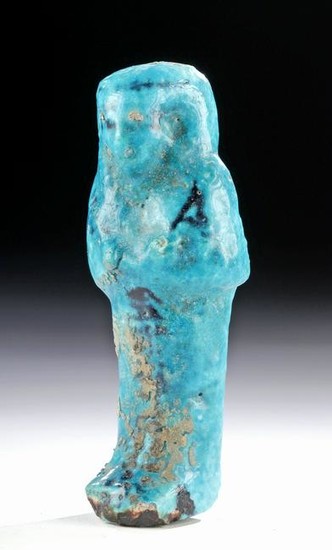Egyptian Glazed Faience Ushabti - Beautiful Blue
Ancient Egypt, Third Intermediate Period, 21st to 25th Dynasty, ca. 1070 to 664 BCE. A fabulous mold-formed faience ushabti figure covered in reflective layers of glaze that exhibits a stunning, cornflower-blue hue. The figure stands in mummiform with fused legs and feet, holds a pick and hoe in arms crossed atop the chest, and has a black seed bag suspended from both shoulders on the verso. The visage exhibits such features as black-painted, almond-shaped eyes, a slightly crested nose, and cupped ears, and a puffy tripartite wig covers the entire head. A single column of black hieroglyphic text is shown atop the front of the legs and, while untranslated, likely provides the names of Osiris and the deceased. A wonderful and colorful example from ancient Egypt! Size: 1.5" W x 3.9" H (3.8 cm x 9.9 cm).
Shabti (or ushabti) dolls are figures shaped like adult male or female mummies wearing traditional ancient Egyptian headdresses. The ancient Egyptians believed that after they died, their spirits would have to work in the "Field of Reeds" owned by the god of the underworld, Osiris. This meant doing agricultural labor was required by all members of society, from workers to pharaohs. By the Third Intermediate period, this practice had become so necessary and elaborate that some tombs contained one worker for every day of the year and thirty-six overseers, each responsible for ten laborers. The wealthier nobility in Egyptian society were able to have shabtis made of coveted faience, and blue faience was meant to reflect the color of the river Nile both on earth and in the afterlife.
Provenance: private A.G. collection, Chicago, Illinois, USA
All items legal to buy/sell under U.S. Statute covering cultural patrimony Code 2600, CHAPTER 14, and are guaranteed to be as described or your money back.
A Certificate of Authenticity will accompany all winning bids.
We ship worldwide to most countries and handle all shipping in-house for your convenience.
#150152
Condition Report: Minor chips to feet, light encrustations, and fading to original black and blue pigment. Nice earthen deposits and original glaze coloration throughout. Original hieroglyphic inscription is illegible.
View it on
Sale price
Estimate
Time, Location
Auction House
Ancient Egypt, Third Intermediate Period, 21st to 25th Dynasty, ca. 1070 to 664 BCE. A fabulous mold-formed faience ushabti figure covered in reflective layers of glaze that exhibits a stunning, cornflower-blue hue. The figure stands in mummiform with fused legs and feet, holds a pick and hoe in arms crossed atop the chest, and has a black seed bag suspended from both shoulders on the verso. The visage exhibits such features as black-painted, almond-shaped eyes, a slightly crested nose, and cupped ears, and a puffy tripartite wig covers the entire head. A single column of black hieroglyphic text is shown atop the front of the legs and, while untranslated, likely provides the names of Osiris and the deceased. A wonderful and colorful example from ancient Egypt! Size: 1.5" W x 3.9" H (3.8 cm x 9.9 cm).
Shabti (or ushabti) dolls are figures shaped like adult male or female mummies wearing traditional ancient Egyptian headdresses. The ancient Egyptians believed that after they died, their spirits would have to work in the "Field of Reeds" owned by the god of the underworld, Osiris. This meant doing agricultural labor was required by all members of society, from workers to pharaohs. By the Third Intermediate period, this practice had become so necessary and elaborate that some tombs contained one worker for every day of the year and thirty-six overseers, each responsible for ten laborers. The wealthier nobility in Egyptian society were able to have shabtis made of coveted faience, and blue faience was meant to reflect the color of the river Nile both on earth and in the afterlife.
Provenance: private A.G. collection, Chicago, Illinois, USA
All items legal to buy/sell under U.S. Statute covering cultural patrimony Code 2600, CHAPTER 14, and are guaranteed to be as described or your money back.
A Certificate of Authenticity will accompany all winning bids.
We ship worldwide to most countries and handle all shipping in-house for your convenience.
#150152
Condition Report: Minor chips to feet, light encrustations, and fading to original black and blue pigment. Nice earthen deposits and original glaze coloration throughout. Original hieroglyphic inscription is illegible.



